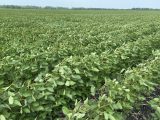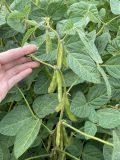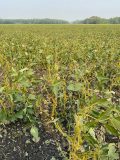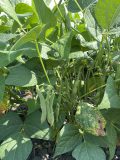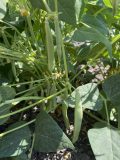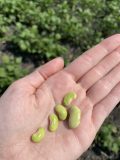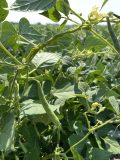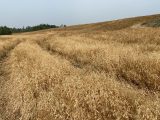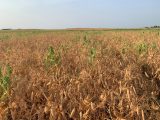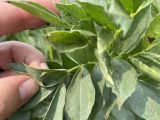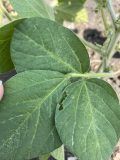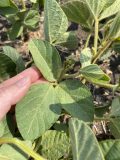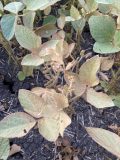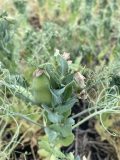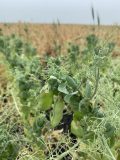August 4, 2021
- Crop Update
- Moisture Stress
- Hail Damage
- Insects
- Diseases
- Two-Spotted Spider Mites
- Soybean Aphids
- Field Pea Preharvest Application Decisions
- On-Farm Network Update: Biologicals – Boom or Bust?
Listen to The Bean Report:
Crop Update
- Soybeans are mainly at the R5 (beginning seed) stage, ranging from R4 (full pod) to R6 (full seed).
- Dry beans currently range from R4 (full pod) to R5 (beginning seed).
- Field peas range from R5 (early maturity) to R7 (full maturity) in fields that are still standing. Harvest of the earliest seeded and earliest maturing crops has begun.
- Faba beans range from R5 (full pod) to R6 (beginning maturity).
Moisture Stress
This seed-filling period is a critical time for moisture (Table 1). Many seeds are filling successfully, albeit ahead of schedule, but we are also seeing some aborted seeds within pods. Rainfall over the next couple of weeks will influence yield outcomes for soybeans and dry beans. Where conditions are dry, crops are much more advanced.
Soybean yields are most sensitive to water deficits during the pod filling stages. A reduction in pod number, as much as 20%, has been reported as a result of flower abortion. Seeds per pod and seed size are also impacted, but to a lesser extent than pod number. Stressed plants often mature earlier, shortening the grain filling period causing reduced seed weight and yield (Iowa State University: Soybean Response to Drought). If adequate rains come after R5 (beginning seed), plants may compensate by producing larger seeds.
Hail Damage
A storm that passed through Manitoba last Friday dropped hail in the central and Interlake regions. Hail damage in the south Interlake is reported to be anywhere from 30% to 100% defoliation in affected soybeans fields and 100% in affected pea fields, with pod drop in both crops. Unfortunately, the R4-R5 soybean stages are still quite sensitive to damage and yield loss can be severe if defoliation is ≥66% (Table 2).

Insects
A few infestations of soybean aphids and two-spotted spider mites have been reported in soybean crops. Once soybeans reach the R6 stage, aphids and spider mites are no longer a threat to yield. Find more information on these pests below. Grasshoppers also continue to be an issue and we will likely see more movement of grasshoppers into soybeans as nearby crops get harvested.
Diseases
Disease pressure remains very low across the province. However, we have seen the odd case of Phytophthora root and stem rot, northern stem canker and white mould. It appears that high disease loads from previous years are the main drivers for development in this dry year. Bacterial blight can also be found in dry bean crops, mainly in the lower canopy.
Two-Spotted Spider Mites
Spider mites love hot, dry conditions and have been moving into soybean fields around the province over the last couple of weeks. They may also move in after previous pyrethroid applications that have killed off mite predators. An early infestation appears as white speckling on the leaves, then progresses to a more webbed-over, chalky appearance. The actual mites can be found on the undersides of leaves, and you may need a magnifying glass to see them.
Consider insecticidal control if 20% of the leaves are infested. The mites move into field edges, progressing inward, and form patches within the field, so spot spraying is often the best option. There are a few products registered for spider mite control, including Lagon and Cygon in soybeans, and Malathion, Oberon and Cygon in dry beans.
Soybean Aphids

- High populations of soybean aphids are erratic and do not occur every year. Soybean aphids arrive in Manitoba predominately by southern winds.
- Soybean aphids pierce plant tissues and feed on the sap. Only 10% of the nutrients they consume are digested, the rest is excreted as honeydew. This results in the sticky, shiny, sap-covered leaves we associate with heavy aphid infestations.
- Scout for aphids until soybeans reach the the R6 (full seed) stage. By full seed (R6), yield loss will be minimal and insecticide applications are no longer economical.
- The action threshold is 250 aphids per plant on average and increasing. Applying below this threshold can cause the aphid population to rebound. This action threshold is a conservative value that allows for a seven-day lead time for control before the aphid population reaches the economic injury level of 674 aphids per plant.
- Natural enemies may provide sufficient control of low aphid populations. The AphidAdvisor app calculates a dynamic action threshold based on soybean aphid and natural enemy counts. Key predators to scout for are lady beetle adults and larvae, green lacewing larvae, hover fly larvae, minute pirate bugs, Aphidoletes larvae and aphid mummies caused by parasitic wasps.
Field Pea Preharvest Application Decisions
Green Pea Plants: Desiccation
Are you dealing with a mature pea crop that has patches of green? If there are green plants that just don’t seem to be maturing and you’re worried about seed staining at harvest, one option is to desiccate. Consult with your buyer on the products they accept and ensure you’re following the preharvest interval. If it’s too late to desiccate, there is the option to swath and leave them for a day or two to dry down (ensuring the winds will be minimal), then combine very soon after. Beware that pea swaths are highly prone to blowing.

One interesting observation from 2021 are these grass-green pea plants that have little to no internode and either no pods or a few poor-producing pods. It is suspected that these are sterile male plants found more commonly this year due to the extended hot temperatures.
Excessive Weed Pressure: Preharvest Weed Control
The Importance of Using Glyphosate Carefully:
- Markets around the would are testing more frequently for chemical residues. Testing is more readily available, cheaper and easier to do than in the past. As a result, there is more scrutiny in the global marketplace.
- Maximum residue levels (MRLs) for glyphosate in pulse crops vary throughout the world and are lower in several Canadian export markets than in Canada. This presents a risk to Canadian farmers. Some markets have no tolerance for glyphosate altogether, due to consumer demand.
- This means it is more important than ever to use glyphosate correctly, following label directions and using it for pre-harvest weed control, not as a desiccant. Staging for applications is critical – applying once the crop is below 30% seed moisture. Below 30% seed moisture coincides with the R7 or full maturity stage, which is described in the video above.
Feeding Pea Straw
When faced with feed shortages, farmers can look to field pea straw as an alternative feed source for cattle. Here are a few things to know about pea straw before feeding:
- Nutrient values of field pea straws are highly variable and a feed analysis is strongly recommended. Rations containing pea straw must also be balanced. Pea straw is useful for beef cow rations where high-quality roughage is not as important as other classes of cattle. When fed with high-quality roughage, grain or a combination of both, pea straw can be a cost-effective ration. Note that cattle must be fed hay rather than straw for at least six weeks prior to calving and throughout the lactation period.
- Pea straws can have significantly higher protein levels compared to cereal straws, but also have higher levels of fibre that may limit digestibility and expected feed intake.
- Diseases affecting peas do not contain toxins or compounds that are considered harmful to cattle. In addition, there is no risk of nitrate accumulation.
- Palatability and intake can be quite variable. It has been reported that cattle either love it or refuse to eat it. Pea straw can be dusty and coarse, which may reduce palatability and intake. Mold will make the straw even less desirable. Processing pea straw by grinding or chopping it with a mix mill or hay buster can improve intake.
- Harvest in a way that leaves the straw as intact as possible. This applies to cereal straws as well. Consider cutting the crop a little higher (e.g., at a 6-inch vs. 3-inch height), so there is some stubble for the straw to lay on for easier pick-up.
- It can be tricky to get pea straw into a bale because plants can be quite brittle and the leaves fall off easily. These bales have been reported to pop apart or explode, so handle carefully.
- Consider planting a cover crop or winter cereal after straw removal for soil cover throughout the fall and winter.
On-Farm Network Update
Biologicals – Boom or Bust?
With multitudes of biological products on the market, claiming to work all sorts of wonders for crop growth, how do you know which products you should invest in, if any? On-farm trials are a useful tool to investigate crop responsiveness to biological trials and return on investment.
This season, the OFN has soybean biological trials investigating the use of EcoTea™, Ohm™ and Primacy ALPHA®. Each of these products is designed to enhance nutrient use efficiency of the crop in some fashion and promote growth. So far, the OFN team hasn’t noted obvious differences in plant growth or vigour between treated and untreated strips in terms of plant height, colour difference or general differences in rate or extent of growth. However, observations are ongoing, and we’ll see what the yield results tell us! In the meantime, explore biological trial results from the last couple of years and take a look at our how-to guide for conducting on-farm trials, if you’re interested in testing out a product in the future!


